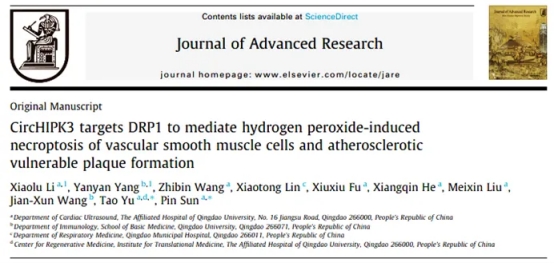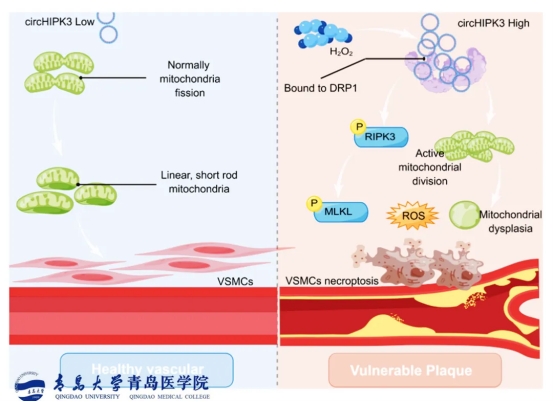The rupture of vulnerable atherosclerotic plaques is the cause of most acute vascular syndromes. Recently, Professor Yu Tao's teamfrom the Institute ofTranslational Medicine published an online paperentitled "CircHIPK3 targets DRP1 to mediate hydrogen peroxide-induced necroptosis of vascular smooth muscle cells and atherosclerotic vulnerable plaque formation" in the "Journal of Advanced Research" (the Chinese Academy of Sciences ranking Q1,IF=11.4). This research was supported by the National Natural Science Foundation of China,the Natural Science Foundation of Shandong Province, and Qingdao Science and Technology Bureau.The first author is PhD student Li Xiaolu from the Medical Department, and the corresponding authors are Professor Yu Taoand Dr.Sun Pin from Qingdao University.

The fibrous cap of the plaque is the main factor for stabilizing plaques, depending on the production of collagen fibers. Vascular smooth muscle cells (VSMCs) secrete collagen fibers, playing a crucial role in the tensile strength of the fibrous cap, thereby being beneficial and necessary for plaque stability. Abnormal death of VSMCs leads to thinning of the fibrous cap, formation of necrotic cores, and plaque calcification, all of which promote the formation of vulnerable plaques. As a recent hotspot in cell death research,necroptosisof cells has been confirmed to exist in the necrotic core of plaques and is closely related to plaque rupture. Circular RNA (circRNA), as a special class of non-coding RNA molecules, has a unique closed-loop structure that is less susceptible to RNase degradation, thus being more stable in expression. However, its regulatory role in thenecroptosisof VSMCs has not been fully explored. This study unveils the role of circRNA in thenecroptosisof VSMCs, particularly in the context of atherosclerosis and the appearance of vulnerable atherosclerotic plaques. CircHIPK3 directly affects the mitochondrial dynamin-related protein 1 (DRP1) in VSMCs, leading to an abnormal increase in mitochondrial fission and ROS production, ultimately causing cellnecroptosisand the formation of necrotic plaque cores. The elucidation of this pathway not only provides a molecular explanation for the progression of atherosclerosis but also highlights the potential of circHIPK3 as a novel biomarker for diagnosing and therapeutically intervening in this cardiovascular pathology.

CircHIPK3 mediates hydrogen peroxidation-induced necroptosis of VSMCs